 | ||||||||||||||||||||||||||||||||||||||||||||||||||
 | ||||||||||||||||||||||||||||||||||||||||||||||||||
First, some background . . . OwlCam, in eastern Massachusetts, USA, must be a very early bird among the owl cams that have appeared on the internet. The first nestbox, initially with no camera, went up in January 1997, and early in April a pair of Barred Owls began to make use of it. Just one chick was seen, but with no internal camera it is not known whether he was the only owlet that spring. Some way of seeing inside the box was needed, and a sensitive black-and-white (daylight only) camera plus two mics were installed above a ceiling panel later in the year. The owl pair had been watching and went into the box for a sneak preview the same evening. Fortunately for us it seems they approved! Ward and June, these two local owls, continued to use the nestbox from 1998 until 2003. For some reason they took a break from raising families in 1999, although they remained in the area that year and visited the box often. The broods they raised over five successful nesting seasons comprised 11 owlets in total. | ||||||||||||||||||||||||||||||||||||||||||||||||||
A colour camera was added in November 1999. This operates from a housing attached to the left side of the box and is the camera that provides most of the internal shots in The Hidden World, which records the three-chick family of 2001. At the time this family was raised there was no infrared camera in the nestbox, so night-time activities are heard but not seen. However, in the film the two internal cameras are backed up by what looks like at least two other cameras with long focal-length telephoto lenses. These are operated from the house, 110 feet away. One lens, used on a roving camera, is almost Hubble-like in power and gives astonishingly good close-ups of the owls (and other local wildlife) wherever they're in view. Another camera is permanently trained on the exterior of the nestbox. Right: A super-telephoto of June, taken from the house. The quality and detail of some of these shots is stunning. (More on camera at end of page.) |  | |||||||||||||||||||||||||||||||||||||||||||||||||
After successfully raising another two chicks in 2002, the next year brought disaster for June and Ward and their new family. A fortnight after the last egg hatched the brood of three was taken in the nestbox by a fisher, a member of the marten family. Both parents were out at the time. The father appears to have fled the area almost immediately. June was seen around until early January 2004, when she too left for good. The owl pair have not used the nestbox since, and it is thought they may have relocated to a neighbour's property about half a mile away. | ||||||||||||||||||||||||||||||||||||||||||||||||||
 | ||||||||||||||||||||||||||||||||||||||||||||||||||
The Hidden World IT' S NOT EASY TO KNOW WHERE to start with a masterpiece! The film's title, of course, refers to the unseen world inside the nestbox.The DVD is divided into five chapters which follow the natural progression of a nesting attempt; these are (1) egg-laying and incubation, (2) the helpless nestling stage, which starts with hatching and ends when the chicks are about two weeks old, (3) the romping stage over the next two weeks, ending with appearances by the two older chicks at the door, (4) the emergence of these two chicks into the outside world, and (5) life outside the nestbox in the early days as wings strengthen until the family can fly off elsewhere. The divisions in the film are a little fuzzier than this as there's a five-day spread between the chicks. About my only and very minor niggle is that the chapters are not titled as they reflect the natural stages in a chick's life. I had put off buying the OwlCam DVD for some time after it appeared. Various reasons, but most of all maybe because I feared disappointment. I'd looked at the samples and somehow they hadn't been quite enough to nudge me over to the ordering page. However, near Christmas 2006 my credit card was in a usable state, there would be time to watch it, and I happened to be looking at the website for other reasons. $20 plus airmail postage -- maybe £15 in all -- how could I put it off any longer. The package crossed the Atlantic inside a week. | ||||||||||||||||||||||||||||||||||||||||||||||||||
Within minutes of popping the DVD in the computer I knew I was looking at something special. Picture quality, editing and content are all excellent. Video quality varies with the camera, but the outside shots range from good to outstanding. The author wisely went to the trouble of installing a side-mounted colour camera in the nestbox. This pays handsome dividends as we see much more of what the mother and chicks are doing than we would with the more usual top-mounted cameras. Not only that, the internal colour camera delivers pretty good-definition footage for a small digital video camera. | ||||||||||||||||||||||||||||||||||||||||||||||||||
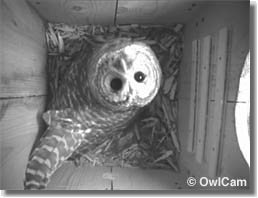 | ||||||||||||||||||||||||||||||||||||||||||||||||||
The view given by the top-mounted black and white camera. It's better quality than the standard webcam and gives a useful additional perspective. Here June's scrutinising it closely during her preparations for egg-laying. For the internal colour camera see the next pic down. | ||||||||||||||||||||||||||||||||||||||||||||||||||
Expert editing As one who's camped under an owl nestbox I found myself instantly drawn in. I'd had to listen, for the most part, to what was going on some way above, but now here it all was, right in front of my nose so to speak, and beautifully filmed. With his array of cameras the author can cut between them to show, for example, an owl sweeping through the trees and then, using the internal colour camera, show her entering the box and what she does inside. Quite often the film cuts to an impressive closeup of a songbird which has been heard in the background, or to some creature an owl has been watching on the ground. Many other inhabitants of the wood make their appearance in this way, some enchanting, others amusing, and some like the fisher or a couple of raccoons menacing, but all add to a pleasing variety of scenes. So there is little sense of restriction to the immediate confines of the nestbox. In fact such deft use is made of the cameras and sound recordings that one could easily mistake the film for a professional product by a natural history unit. Expert editing means the story flows without interruption, allowing one to become completely absorbed. The commentary is restrained and informative. | ||||||||||||||||||||||||||||||||||||||||||||||||||
A family is raised And what an engaging story it is! The devotion of this Barred Owl pair, especially the mother, June, comes through in every frame. The family make it through snow, rain, thunderstorms, harrassment by neighbours who'd rather they moved on, and some heart-stopping moments of crisis. I was particularly interested to see the shelter the mother forms with her wings around the helpless chicks in their first 10 days or so (right). With them on the litter beneath her, she extends her wings downwards to form a cosy, walled space. Being very long-sighted, every now and again she raises her head high to look down for a quick visual check. In Chapter 2 we see how she prepares (rips!) the morsels brought by Ward, the father, to share out between them. She seems to remember who's been fed and makes sure that everyone gets something in the end -- Ernie, the youngest, may get food last but he's never forgotten. We also see many of the prey items that are brought in, so you learn a lot about a Barred Owl's diet. Voles, for sure, but also small (and not so small) birds, frogs, a snake and, when the hunting's tough for Ward in wet weather, well, if you're a baby owl you just have to get by on earthworms. A hilarious insight into the young chicks' behaviour comes in Chapter 3. Here, aged about 3 weeks, the two oldest are shown propellng themselves around on their tums with vigorous kicks while Ernie, the youngest, sits in a corner as if pretending to be a paddle-steamer is quite beneath him. These first two chicks, Emmett and Abigail, clearly formed a bond at an early stage that persisted until months later. They are often seen doing things together, even during a return to the nestbox area in mid-September. Little Ernie is left out of this and has to make out on his own. | ||||||||||||||||||||||||||||||||||||||||||||||||||
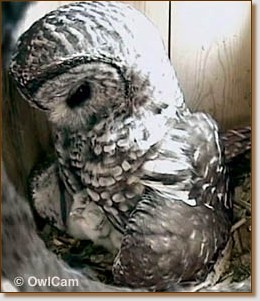 | ||||||||||||||||||||||||||||||||||||||||||||||||||
When the chicks are still very young June forms a warm, protective space around them with her wings. This is the view given by the side-mounted colour camera. There are excellent sequences showing the first chick hatching from the egg. Later one sees June watching a chick carefully if she's given it something especially large to swallow. | ||||||||||||||||||||||||||||||||||||||||||||||||||
 |  | |||||||||||||||||||||||||||||||||||||||||||||||||
Left: When the mother turns up at the nestbox (in Ch 2) we see just what a big girl she is. Right: Ward brings in a small snake. Skilful camera work allows one to see what the owls are up to in detail. These are "standard" telephoto views taken from the house. The cameras are on tripods and the image is always steady. | ||||||||||||||||||||||||||||||||||||||||||||||||||
Out of the box . . Chapter 4 deals with a momentous time in the life of any young owl, which is when it leaves the safety of the nest. The older pair do it together though a few days apart in age. The film shows that leaving the nest isn't something you do just like that. For several days beforehand the two chicks make tentative appearances at the door before wisely popping back inside. On one occasion Emmett is given one hell of a scare by a sudden bolt of lightning. The thunder roars so loud the picture rocks and judders. Clack, clack, goes his not so little beak, and he cowers back in the doorway. The story is nothing if not full of drama. | ||||||||||||||||||||||||||||||||||||||||||||||||||
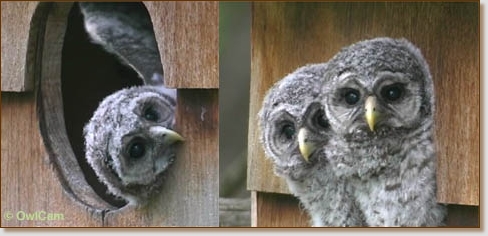 | ||||||||||||||||||||||||||||||||||||||||||||||||||
 | ||||||||||||||||||||||||||||||||||||||||||||||||||
Top left: A little owl (Emmett) getting his very first glimpse of the world outside.Top right: Soon there are two in the doorway as Abigail's determined to join him.These are "super-telephoto" views. Lower right: With Emmett now on the roof, mother flies in for one of her frequent checks and Ernie stares hard at her for reassurance -- he's already concerned about his junior status! A feature of the film is June's constant attention to how each chick is faring in any particular situation. ("Standard" telephoto shot) | ||||||||||||||||||||||||||||||||||||||||||||||||||
. . and into the trees Chapter 4 contains a sequence showing the ability of chicks of this age to climb a large-diameter vertical tree trunk (one of those behind the nestbox) with no aids but beak, sharp claws and wings. This is a remarkable sequence and I wonder if it has been seen before on film. For me it was an eye-opener. The chapter concludes with shots of the first two owlets learning to cope with the world outside and keeping a grip on its wet, slippery branches. In brilliantly caught scenes the mother, who has been watching over her little family from a nearby perch, goes over to congratulate the two older chicks on their feat before flying over to comfort Ernie, who's stranded disconsolately at the nestbox. It's most touching and evidence of how intelligently a mother owl may monitor and react to her children's efforts. The first part of Chapter 5 focuses on what happens to the youngest chick, Ernie. Anxious to catch up with the rest of the family despite his relative youth -- he's still only 29 days old and just too young to fly -- he takes a leap straight off the nestbox into empty air. So plucky, but it's an act of desperation as there are no trees or branches in that direction, just the floor of the forest 25 feet below. Happily he made it to safety before nightfall, when he could have been in dead trouble. | ||||||||||||||||||||||||||||||||||||||||||||||||||
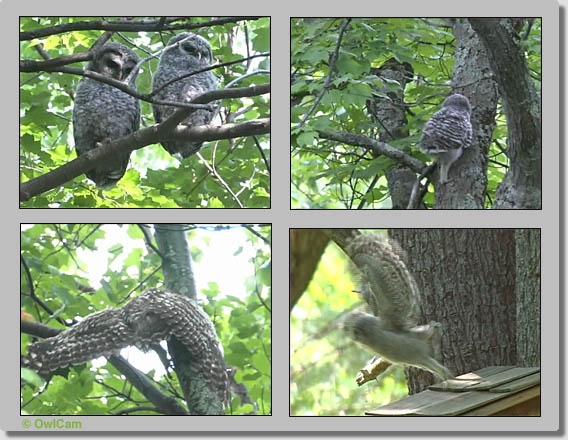 | ||||||||||||||||||||||||||||||||||||||||||||||||||
Babes in the wood. Top left: These two take a break. Top right: Walking confidently up a steep tree trunk. Bottom left: The oldest owlet, just out, has a spot of bother on wet branches. Bottom right: Ernie, the youngest, keen to play catchup, makes a wild bid to join the others. Unable to fly, he ends up on the ground but lives to tell the tale. | ||||||||||||||||||||||||||||||||||||||||||||||||||
Although the children are enchanting, and our hearts go out to them, June is the focus, the star of this movie. Nesting and motherhood are her show, and it is she who directs proceedings, shepherding her little crew through every stage. Indispensible as he is, Ward is left to run and fetch and otherwise look, well, a little sidelined, a bit like a human father. He is the breadwinner and takes little part in what goes on at the nest. In fact, after many viewings it is the evidence of the intelligence and awareness a mother owl applies to the whole nesting business that for me is emerging as the really remarkable aspect of this film. Raising a family seems to be no mere instinct-driven process. At one level, of course, it is, but above that it's very evident that there's another, much more conscious, level of vigilance, concern, monitoring and supervision where the mother displays her individual characteristics and experience. It's here that, good as it is, I find myself for once unconvinced by the commentary in part of Chapter 5. It is suggested that the parents are becoming impatient with the way the youngest chick has been left marooned at the box. In fact what the movie shows us is that the mother goes over, twice, to comfort little Ernie and quite likely even to try to calm him. My reading of her behaviour is that she's letting the chick know there's no hurry, that he can take his time. It's his own frustration that drives him to jump from the roof before he should, not (so far as we are shown) any encouragement to do so by June. There's no evidence of the parents' hurry to move the family elsewhere in the way they subsequently remained near the house for about a fortnight. (See footnote) Anyway, the time does at last come when the owl family vanishes into the woods, heading for another part of the territory. Two of the owlets are shown on a brief return to the nesting area over the summer, but nothing was known of Ernie's fate until quite late in the year, when at last he too showed up, magnificent with a striking plumage of pale feathers on his chest. So the film is able to close on a happy note as it's not at all a foregone conclusion that all three of a brood should survive even that long. | ||||||||||||||||||||||||||||||||||||||||||||||||||
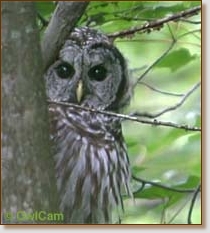 | ||||||||||||||||||||||||||||||||||||||||||||||||||
June, the ever vigilant mother, is a star. Here, her eyes dark with concern, she's watching Ernie on the ground. Below: moral support for Ernie while he was still marooned at the nestbox. | ||||||||||||||||||||||||||||||||||||||||||||||||||
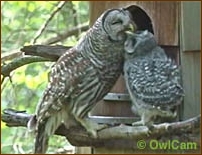 | ||||||||||||||||||||||||||||||||||||||||||||||||||
 | 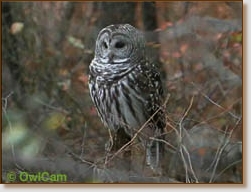 | |||||||||||||||||||||||||||||||||||||||||||||||||
Ernie filmed on his return to the nestbox area late in the autumn. The development of an owl is an amazing thing, and the little creature that almost didn't make it has become a particularly striking bird. | ||||||||||||||||||||||||||||||||||||||||||||||||||
An unmissable film for owl-lovers No simple description like mine can do justice to this marvellous film. Having now watched it many times -- not least to revise this review and choose the stills! -- I am in awe of the OwlCam author's achievement. He has managed to show so much of what goes into the raising of a young owl family in a way that has me both admiring at the technical achievement and completely absorbed. Expert filming, faultless editing, the sparse, well-judged and informative commentary and, not least, the luck of having such wonderful owls doing their thing right in your backyard make for an unforgettable experience. Some scenes are very moving and may bring a tear to many an eye. The movie shows how involved one can become with owls -- the way they take on individuality, how you start reading their minds, how they become almost an extension of the family, and how when they move on they can leave a big, empty space in your life. The film itself, and the dedication that has so evidently gone into its making, are testament to that. In one way it's a very personal movie, for these are the author's owls and no one else's, and one is grateful that he's gone to such lengths to share the experience. On the box it is suggested that this is the first time Barred Owls' nesting has been filmed in such detail. That may be, but I doubt that this movie will be equalled, let alone surpassed, in a long time. Go get -- it's a real little classic.
OwlCam DVD webpage (click to leave this website) | ||||||||||||||||||||||||||||||||||||||||||||||||||
Note on the super-telephoto (information from OwlCam) "The extreme close-ups were the product of a 600mm/f4 Canon photo lens mounted on a Canon XL1 video camera. The 7.1 multiplication factor of the lens adapter resulted in a 35mm equivalent focal length of about 4,300 mm. This just filled the frame with the 8-inch nest box door at 110 feet." My comment: Top-notch gear! So when I talk of "standard" telephoto in the review I guess I'm referring to the 600 mm lens used without the adapter, while "super-telephoto" means when the adapter's attached. I think that focal length of 4,300 mm when the adapter's used means there's a magnification of somewhere between 80 and 100 times! (Back to top of page)
Footnote on owl identities in first part of Chapter 5 There's a little bit of a complication here as in these sequences the film's author had to turn to footage of other years' owlets to illustrate the events of 2001 in full. This is acknowledged in the credits at the end of the video. However, I don't think these substitutions materially affect the interpretation I'm putting on June's behaviour. Whether she did it one year or another makes little difference. The owlet shown in the Ernie sequences appears to be Penelope, from 2002. A precise description of the events that preceded Penelope's leap can be found on this page on the OwlCam website. (Back to where you were) | ||||||||||||||||||||||||||||||||||||||||||||||||||
Sophie's Seal of Approval | ||||||||||||||||||||||||||||||||||||||||||||||||||
This is the old pic from the top of the review showing my owl looking at the OwlCam DVD box (click for large version). She's endlessly entertained by the video and will spend hours watching -- like 10 hours the day I was preparing the pics for the review. I only have to show her the box or turn on the sound system and she'll fly to her watching perch. She gets pretty involved too -- there's a scene where a grey squirrel harrasses June, and Sophie dives in to the attack every time! Funnily enough the red squirrels and chipmunk that appear from time to time don't bother her. | ||||||||||||||||||||||||||||||||||||||||||||||||||
(Review first appeared January 2007; revised and updated December 2007. My thanks to the film's maker for contributing information for the review, which expresses my opinions alone. Any errors are mine.) | ||||||||||||||||||||||||||||||||||||||||||||||||||
 | ||||||||||||||||||||||||||||||||||||||||||||||||||
powered by owls | ||||||||||||||||||||||||||||||||||||||||||||||||||
Title: The Hidden World
Produced by Owlbox Productions (2006)
Distributed by FilmBaby, Portland, Oregon
DVD video in NTSC format, full screen, 4:3 aspect ratio, stereo, single disk, 110 minutes, 23 scene selections. Commentary in english.
Price (December 2007) US$19.95 + $3.99 postage in US, $5.75 elsewhere (Worldwide International Air)
OwlCam DVD webpage (samples and sales)

Ward gives June a nibble . . but her mind's on the chicks. A powerful telephoto gives breathtaking close-ups.
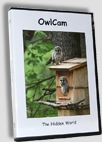
The Hidden World
Review of the Barred Owl DVD from OwlCam